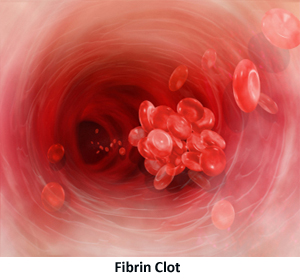How Blood Works in a Person With Hemophilia
 As explained in Understanding How Blood Works, bleeding is supposed to stop after three things happen:
As explained in Understanding How Blood Works, bleeding is supposed to stop after three things happen:
- The injured blood vessel gets smaller to let less blood through.
- Platelets rush to the site and stick together to form a platelet plug. The platelets do this through adhesion, activation and secretion, and aggregation.
- Clotting factor proteins in the blood work together to make threads of fibrin. The fibrin weaves itself into a clot over the platelet plug. This makes a strong seal, allowing healing and rebuilding of the damaged blood vessel.
People with Hemophilia Can't Make a Fibrin Clot
The first two steps to stop bleeding usually work just fine in a person with Hemophilia. The blood vessel gets smaller, and the platelets make a plug.
Some people think a person with Hemophilia can bleed to death from a small cut. This is not true. The first two steps are usually able to stop bleeding from cuts and scrapes.
A person with Hemophilia has problems when a fibrin clot is needed to stop the bleeding and prevent rebleeding and oozing. People with Hemophilia don't have enough of certain clotting factors. Because of this, the fibrin clot is not made or is so thin and weak that the bleeding goes on and can rebleed.
Someone with Hemophilia does not bleed faster than someone without Hemophilia. However, the person with Hemophilia will bleed longer.
Bleeding Inside the Body is the Big Problem
Bleeding inside the body is more of a problem for people with Hemophilia than bleeding on the outside from a cut or scrape. Inside the body, the blood can go into spaces in joints, muscles, and organs. This can cause great damage, especially if the bleeding is not treated or happens over and over.
Often, the bleeding, especially bleeding in muscles and joints, is caused by a previous injury no matter how small. The person with Hemophilia might bump their knee or hit their elbow thinking nothing of it initially. However, for some people with Hemophilia, the bleeding can start for no clear reason. For example, the person with Hemophilia could just be walking and develop bleeding in their knee. This is called a "spontaneous bleed." Whether caused by an injury or spontaneous, bleeding must be treated as soon as possible.
People with Hemophilia usually don't say they are bleeding. They say they are having "a bleed." You will hear them say, "I had four bleeds last month," or "It feels like I'm having a bleed in my ankle."
